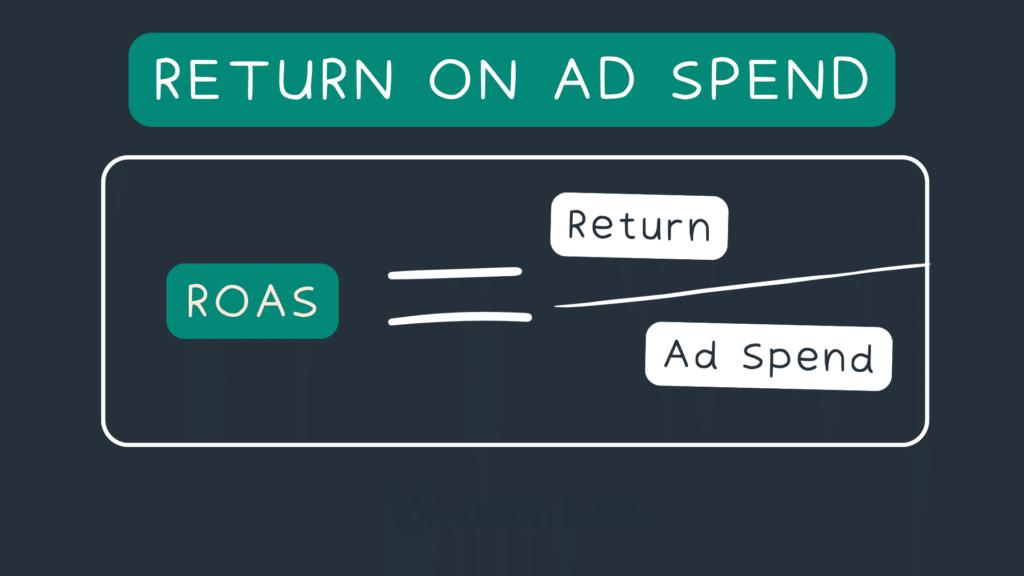ROAS Calculator for ecommerce teams
Calculate your ROAS easily with this online calculator, refine your results by also calculating acquisition efficiency and LTV cohorts.
Calculate your ROAS ⬇️
Refine Your Answer
Lifetime Value (LTV) & Projection
Have you thought about working with Vision Labs (that's us) to help build a marketing data system that uses data you can actually execute against?
I would suggest you hop on over to VisionLabs.com/contact & let's have a conversation about your data future & how we can help get you there faster than ever before!
Talk soon,
JJ Reynolds
Founder | Vision Labs
How to calculate Return on Ad Spend (ROAS)? Formula
The formula to calculate ROAS is: total revenue generated from Ads divided by Amount spent in ADS in a specific period of time
Let’s say you spent $1,000 on an advertising campaign, and it generated $1,500 in attributed revenue.
- ROAS = Attributed Revenue / Ad Spend
- ROAS = $1,500 / $1,000 = 1.5
This means that for every $1 spent on advertising, you generated $1.50 in revenue

How to Analyze Return on Ad Spend (ROAS)?
Whether you’re using Facebook Ads or Google Ads, the interpretation of ROAS remains consistent:
- A ROAS of 1 means you’re breaking even
- ROAS > 1 indicates profit (e.g., 2 means $2 revenue for every $1 spent)
- ROAS < 1 means you’re losing money on ad spend
Remember: While calculation methods may vary slightly, the meaning of your ROAS figure is universal across platforms. Use it to gauge ad performance and guide optimization efforts regardless of the advertising channel.
To interpret ROAS (Return on Ad Spend), consider the following key points:
- Basic interpretation: ROAS tells you how much revenue you generate for every dollar spent on advertising. For example, a ROAS of 1.5 means you earn $1.50 for every $1 spent on ads.
- Benchmarks: While a “good” ROAS varies by industry and business model, a common benchmark for eCommerce businesses is 3:1, meaning $3 earned for every $1 spent.
- Break-even point: Consider your break-even ROAS, which is the minimum ROAS needed to cover your ad costs and other expenses. For instance, if your break-even ROAS is 1.8, you need to earn at least $1.80 for every dollar spent to remain profitable.
- Campaign comparison: Use ROAS to compare the effectiveness of different campaigns, ad sets, or platforms. Higher ROAS indicates better performance.
- Scalability: A very high ROAS might suggest that you’re not scaling your ad spend aggressively enough. If you’re seeing significant returns, you may want to consider increasing your ad budget to maximize growth.
- Holistic view: Remember that while ROAS is valuable for assessing ad performance, it shouldn’t be used in isolation. Consider it alongside other metrics like Average Order Value (AOV), conversion rate, and Customer Acquisition Cost (CAC) for a more comprehensive understanding of your marketing performance.
What is Return on Ad Spend (ROAS)?
ROAS stands for Return on Ad Spend. It is a marketing metric that measures the revenue generated for every dollar spent on advertising.
Specifically, ROAS focuses on the performance of individual advertising campaigns, ad sets, or ads within a particular platform, making it different from broader business metrics like Return on Investment (ROI).
FAQ's
Why is ROAS important?
ROAS is important because it:
- Measures campaign effectiveness: It shows how well advertising campaigns are performing.
- Guides budget allocation: It helps marketers decide where to invest their ad spend for maximum profitability.
- Optimization: It identifies which campaigns are driving revenue and which need adjustments.
- Demonstrates marketing value: It shows the direct impact of advertising efforts on revenue.
- Supports decision-making: It helps marketers decide whether to scale, pause, or optimize campaigns.
While ROAS is valuable, it should be used alongside other metrics like Average Order Value (AOV) and Customer Acquisition Cost (CAC).
What are the best practices for improving ROAS?
To improve ROAS (Return on Ad Spend), consider the following strategies:
- Optimize conversion rate (CRO): Improve your website's user experience, simplify the checkout process, adress your customer pains or questions, add user generated content providing social proof and adress customer concerns.
- Increase Average Order Value (AOV): Offer upsells, cross-sells, or product bundles to boost revenue per transaction without increasing ad spend. Also you could add an unique one time offer after the first-purchase to nudge the customer into making a second purchase.
- Improve ad creatives: Ad creatives are one of the most important things you can experiment with to drive higher engagement and conversions.
- Leverage retargeting: Use retargeting ads to re-engage users who have previously interacted with your website but didn't convert.
- Monitor and adjust campaigns: Know your break-even ROAS Calculate the ROAS level where campaigns become profitable. Use this to guide scaling decisions.
- Improve attribution accuracy: Ensure you're using consistent attribution models for reliable ROAS calculations. For instance, you could use Meta's 7-day click attribution.
Can I use this calculator for Google Ads and Facebook Ads?
Yes, you can use ROAS calculators for both Facebook Ads and Google Ads. The basic principle is the same for both platforms:
Facebook Ads: Use Facebook's attribution system and select a consistent attribution window (e.g., 7-day click).
Google Ads: Use Google Ads' conversion tracking and choose a consistent attribution model.
For both, divide the attributed revenue by your ad spend to calculate ROAS.
The formula is the same for both:
ROAS = Revenue attributed to ads / Ad spend
Ensure you're using consistent attribution settings within each platform for accurate comparisons.
How often should I check my ROAS?
Monitor ROAS regularly, but avoid making decisions based on very short time frames:
- Daily: For high-spend accounts or during promotions
- Weekly: For most e-commerce businesses
- Monthly: For longer sales cycles or B2B companies
Always consider broader trends rather than reacting to daily fluctuations.
Should I always aim for the highest possible ROAS?
Not necessarily. While a high ROAS is generally good, focusing solely on maximizing ROAS can limit growth. Sometimes, accepting a lower ROAS can allow you to reach more customers and increase overall profit.
What are the common mistakes when calculating ROAS?
Avoid these frequent errors to ensure accurate ROAS calculations:
- Inconsistent attribution windows:
• Mistake: Using different time frames across campaigns or platforms
• Fix: Stick to a consistent attribution window (e.g., 7-day click for Facebook Ads) - Misattributing revenue:
• Mistake: Counting revenue from organic or email traffic as ad-driven
• Fix: Use proper tracking and attribution models to isolate ad-generated revenue
We can help with this at VisionLabs 😉 - Overlooking refunds or returns:
• Mistake: Failing to subtract returned purchases from revenue
• Fix: Regularly update revenue figures to account for returns - Using incomplete data:
• Mistake: Calculating ROAS before all attributed sales are recorded
• Fix: Allow sufficient time for all conversions to be tracked before finalizing ROAS - Focusing on short time frames:
• Mistake: Making decisions based on daily ROAS fluctuations
• Fix: Look at longer-term trends (weekly or monthly) for more reliable insights - Not segmenting data:
• Mistake: Calculating only overall ROAS, missing insights from specific campaigns or ad sets
• Fix: Break down ROAS by campaign, ad set, and even individual ads for deeper analysis

JJ Reynolds
JJ Reynolds is the founder of Vision Labs, a white-label data agency specializing in custom measurement systems and real-time marketing dashboards. Having worked with startups to multi-billion dollar companies, he creates bespoke reporting solutions that help businesses turn data into decisions. His expertise in media buying, PPC, and analytics enables companies of all sizes to make smarter, data-driven choices.
All Marketing calculators
Get notified immediately as new calculators & strategies are launched
Join 6,000+ D2C Brands, Marketers, & Analysts who want to act on their data